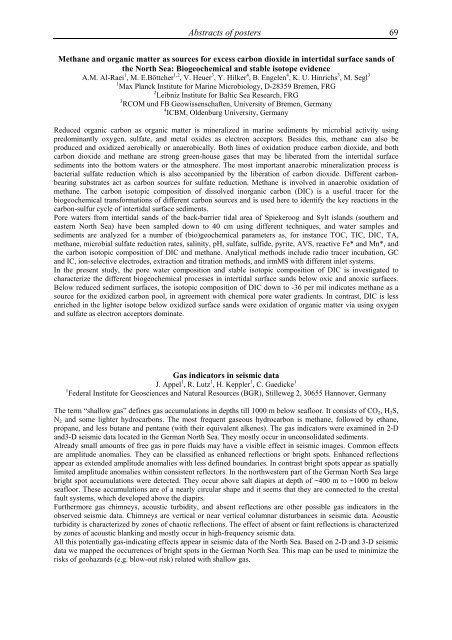Ninth international conference on - Marum
Ninth international conference on - Marum
Ninth international conference on - Marum
Create successful ePaper yourself
Turn your PDF publications into a flip-book with our unique Google optimized e-Paper software.
Abstracts of posters 69<br />
Methane and organic matter as sources for excess carb<strong>on</strong> dioxide in intertidal surface sands of<br />
the North Sea: Biogeochemical and stable isotope evidence<br />
A.M. Al-Raei 1 , M. E.Böttcher 1,2 , V. Heuer 3 , Y. Hilker 4 , B. Engelen 4 , K. U. Hinrichs 3 , M. Segl 3<br />
1 Max Planck Institute for Marine Microbiology, D-28359 Bremen, FRG<br />
2 Leibniz Institute for Baltic Sea Research, FRG<br />
3 RCOM und FB Geowissenschaften, University of Bremen, Germany<br />
4 ICBM, Oldenburg University, Germany<br />
Reduced organic carb<strong>on</strong> as organic matter is mineralized in marine sediments by microbial activity using<br />
predominantly oxygen, sulfate, and metal oxides as electr<strong>on</strong> acceptors. Besides this, methane can also be<br />
produced and oxidized aerobically or anaerobically. Both lines of oxidati<strong>on</strong> produce carb<strong>on</strong> dioxide, and both<br />
carb<strong>on</strong> dioxide and methane are str<strong>on</strong>g green-house gases that may be liberated from the intertidal surface<br />
sediments into the bottom waters or the atmosphere. The most important anaerobic mineralizati<strong>on</strong> process is<br />
bacterial sulfate reducti<strong>on</strong> which is also accompanied by the liberati<strong>on</strong> of carb<strong>on</strong> dioxide. Different carb<strong>on</strong>bearing<br />
substrates act as carb<strong>on</strong> sources for sulfate reducti<strong>on</strong>. Methane is involved in anaerobic oxidati<strong>on</strong> of<br />
methane. The carb<strong>on</strong> isotopic compositi<strong>on</strong> of dissolved inorganic carb<strong>on</strong> (DIC) is a useful tracer for the<br />
biogeochemical transformati<strong>on</strong>s of different carb<strong>on</strong> sources and is used here to identify the key reacti<strong>on</strong>s in the<br />
carb<strong>on</strong>-sulfur cycle of intertidal surface sediments.<br />
Pore waters from intertidal sands of the back-barrier tidal area of Spiekeroog and Sylt islands (southern and<br />
eastern North Sea) have been sampled down to 40 cm using different techniques, and water samples and<br />
sediments are analyzed for a number of (bio)geochemical parameters as, for instance TOC, TIC, DIC, TA,<br />
methane, microbial sulfate reducti<strong>on</strong> rates, salinity, pH, sulfate, sulfide, pyrite, AVS, reactive Fe* and Mn*, and<br />
the carb<strong>on</strong> isotopic compositi<strong>on</strong> of DIC and methane. Analytical methods include radio tracer incubati<strong>on</strong>, GC<br />
and IC, i<strong>on</strong>-selective electrodes, extracti<strong>on</strong> and titrati<strong>on</strong> methods, and irmMS with different inlet systems.<br />
In the present study, the pore water compositi<strong>on</strong> and stable isotopic compositi<strong>on</strong> of DIC is investigated to<br />
characterize the different biogeochemical processes in intertidal surface sands below oxic and anoxic surfaces.<br />
Below reduced sediment surfaces, the isotopic compositi<strong>on</strong> of DIC down to -36 per mil indicates methane as a<br />
source for the oxidized carb<strong>on</strong> pool, in agreement with chemical pore water gradients. In c<strong>on</strong>trast, DIC is less<br />
enriched in the lighter isotope below oxidized surface sands were oxidati<strong>on</strong> of organic matter via using oxygen<br />
and sulfate as electr<strong>on</strong> acceptors dominate.<br />
Gas indicators in seismic data<br />
J. Appel 1 , R. Lutz 1 , H. Keppler 1 , C. Gaedicke 1<br />
1 Federal Institute for Geosciences and Natural Resources (BGR), Stilleweg 2, 30655 Hannover, Germany<br />
The term “shallow gas” defines gas accumulati<strong>on</strong>s in depths till 1000 m below seafloor. It c<strong>on</strong>sists of CO2, H2S,<br />
N2 and some lighter hydrocarb<strong>on</strong>s. The most frequent gaseous hydrocarb<strong>on</strong> is methane, followed by ethane,<br />
propane, and less butane and pentane (with their equivalent alkenes). The gas indicators were examined in 2-D<br />
and3-D seismic data located in the German North Sea. They mostly occur in unc<strong>on</strong>solidated sediments.<br />
Already small amounts of free gas in pore fluids may have a visible effect in seismic images. Comm<strong>on</strong> effects<br />
are amplitude anomalies. They can be classified as enhanced reflecti<strong>on</strong>s or bright spots. Enhanced reflecti<strong>on</strong>s<br />
appear as extended amplitude anomalies with less defined boundaries. In c<strong>on</strong>trast bright spots appear as spatially<br />
limited amplitude anomalies within c<strong>on</strong>sistent reflectors. In the northwestern part of the German North Sea large<br />
bright spot accumulati<strong>on</strong>s were detected. They occur above salt diapirs at depth of ~400 m to ~1000 m below<br />
seafloor. These accumulati<strong>on</strong>s are of a nearly circular shape and it seems that they are c<strong>on</strong>nected to the crestal<br />
fault systems, which developed above the diapirs.<br />
Furthermore gas chimneys, acoustic turbidity, and absent reflecti<strong>on</strong>s are other possible gas indicators in the<br />
observed seismic data. Chimneys are vertical or near vertical columnar disturbances in seismic data. Acoustic<br />
turbidity is characterized by z<strong>on</strong>es of chaotic reflecti<strong>on</strong>s. The effect of absent or faint reflecti<strong>on</strong>s is characterized<br />
by z<strong>on</strong>es of acoustic blanking and mostly occur in high-frequency seismic data.<br />
All this potentially gas-indicating effects appear in seismic data of the North Sea. Based <strong>on</strong> 2-D and 3-D seismic<br />
data we mapped the occurrences of bright spots in the German North Sea. This map can be used to minimize the<br />
risks of geohazards (e.g. blow-out risk) related with shallow gas.














